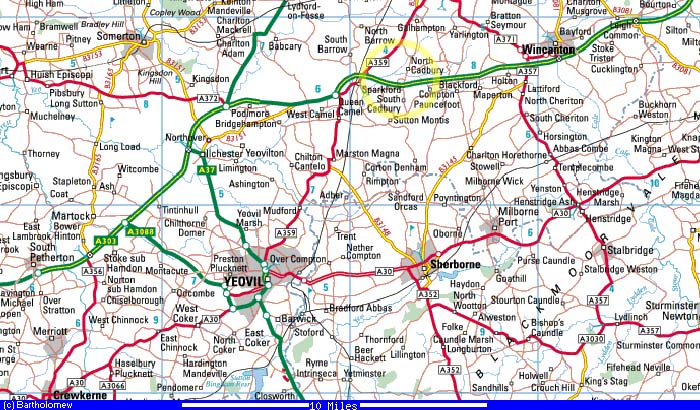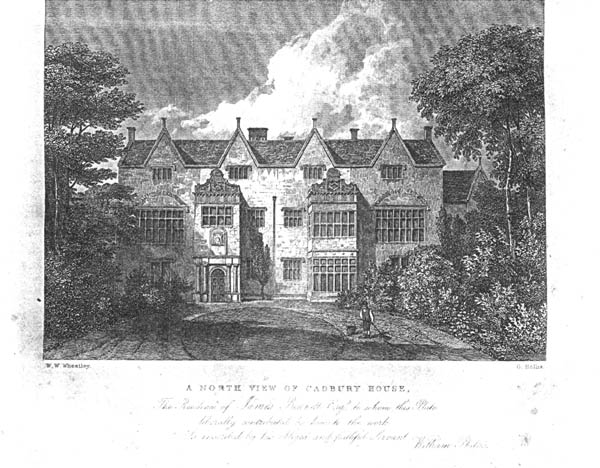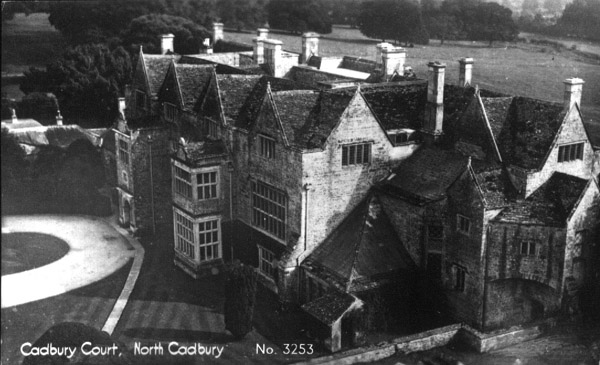
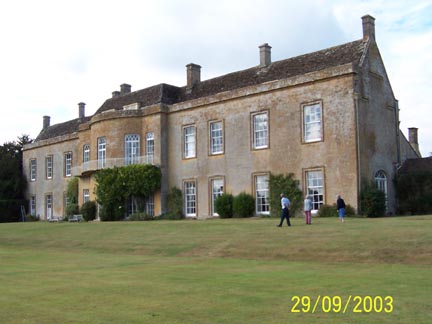
Cadbury Court, Somerset (CJEN 2001 and 2003)
Views of the Tudor facade on the north side and the Georgian facade on south side of the Court


North Cadbury was one of several estates that were owned by the Newman family. Others included Fifehead Manor (in Dorset), Evercreech Park, Sparkford Manor (both in Somerset), North Lease Park and Thornbury Park in Gloucestershire. The North Cadbury estate (also in Somerset) is located in the village of North Cadbury a few miles to the north-east of Yeovil, just east of the village of Sparkford. South Cadbury estate also came into the ownership of the Newman family at the same time as North Cadbury.
For a long time it was believed that the Newmans bought the estates in 1610 but evidence unearthed by Harold Biggs shows the date to have been 1685. On page 394, the history and antiquities of Somersetshire Vol 1, Parts 3-6" by William Phelps states that "... after the death of Sir Francis Hastings in 1610, "by some family arrangement the manors and estates of North and South-Cadbury were sold to Richard Newman, Esq High-Steward of Westminster", however the Somersetshire Archeological and Natural History Society's Proceedings, 1870 VOL. XVI. Pages 21,22,23 states that Arthur Ducke, Doctor of Civil Law, was the owner of North and South Cadbury until his death in 1649, when the estates were inherited by his daughter Mary, wife of William Harbord. According to Frederic Weaver's Notes & Queries for Somerset ad Dorset (1893), she and her husband sold them to Richard Newman, her brother-in-law, in 1685.
An outline history of North Cadbury Court can be found at the North Cadbury Court website. This states that:
the house's history dates back 700 years to the early 1300s. It was first a medieval hall built of which the original magnificent roof trusses are visible in several rooms today. Then in 1337 it was sold to William Botreaux from Cornwall a descendant of whom, Elizabeth Botreaux, rebuilt the neighbouring church in the early 1400s and founded a college for priests in 1427 in the house, though this was never established. Sir Francis Hastings leased the building from his brother, the Earl of Huntingdon and in 1580s built the large Elizabethan mansion (incorporating part of the old hall) before it was sold in 1596 to Matthew Ewens, a Baron of the Exchequer.
In 1610 it was purchased by Richard Newman who had the misfortune of being imprisoned by Oliver Cromwell for lending his support to King Charles I but was forgiven a little later by King Charles II. The house and estates stayed in the Newman family for another 150 years. [It is understood that this statement was based on information provided by this website prior to 2020.]
The Bennett family purchased the house and its lands in the 1760’s and it remained in their family for the next 100 years. During that time they added a ballroom and the very attractive Georgian style south façade and their coat of arms can still be seen above the main door. [In fact it was c.1695 that the Bennetts took possession of Cadbury Court when Frank Newman moved to Piddletrenthide.]
In 1910 the house and estate was purchased by Sir Archibald Langman (grandfather of the current owner, Archie Montgomery).
A lengthy description of North Cadbury and its history appears on page 394 of "the history and antiquities of Somersetshire Vol 1, Parts 3-6" by William Phelps whic begins with what is now believed to be an erroneous paragraph:
... after the death of Sir Francis Hastings in 1610, "by some family arrangement the manors and estates of North and South-Cadbury were sold to Richard Newman, Esq. High-Steward of Westminster. This gentleman was the firm and attached friend of Charles I. whom he attended in his difficulties, and supplied with large sums of money. For his loyal conduct, Charles II. when he was restored to the throne of his ancestors, granted this Richard Newman of Cadbury an augmentation of the family arms. viz. Guiles, a protcullis crowned Or. He previously bore, Quarterly Ermine and Argent, in first and fourth quarters three mullets of the Second. [See Richard Newman's page for further comment on this statement]
The manor and estate descended from father to son to Francis Newman Esq. who died in 1768 without issue, and by his will entailed the manors of North and South-Cadbury on Francis and Henry, the two sons of his brother Henry [this is incorrect - Francis and Henry were sons of his brother Charles], and their male issue in succession. The former of these enjoyed the estates until 1796 when he died [this is also iincorrect; Francis died in Piddletrenthide in 1796 after abandoning Cadbury Court], leaving three daughters, Jane, wife of Wm Walter Yea, eldest son of Sir Wm. Yea, Bart.; Catherine, married James Rogers, D.D. rector of South Cadbury; and the eldest Frances-Charlotte, married her first cousin Francis, the eldest son of Henry Newman, on whom the estates were entailed.
Francis Newman the younger, during his uncle's life, sold his reversionary interest in the property to James Bennett, Esq. of London, viz. the two Cadbury's in 1790, and Sparkford in 1793. On his uncle's death, Mr Bennett succeeded to the estates [see above: Bennett succeeded to the estates before Frank's death]. He served the office of Sheriff in 1799, and died in 1815, leaving North and South Cadbury to his eldest son James; and Sparkford to his youngest son Henry, who is also Rector of that parish and of South Cadbury."
Description of the House
The 1581 building was constructed in the Tudor style, with a large courtyard on the south side with a tower containing a spiral staircase on the north-western corner. The appearance of the original tudor building is shown in the paintings below, currently hanging in the entrance hall of the tudor section:

This painting shows the north front looking much as it does
today (though there is no longer a gatehouse). To the right of the house is
the church.
Above the church is the hill known as Cadbury Castle beleived (by some) to have
been the location of King Arthur's Camelot.
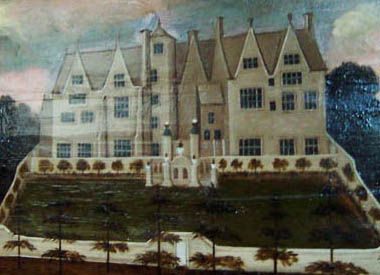
The south facade was also in the Tudor style, incorporating a spiral staircase inside the tower just to left of centre (as desribed above).
The paintings above show the appearance of the house during its century and a half of Newman occupation. When the house passed into Bennett ownership at the end of the 18th century, the entire south frontage was removed and replaced with a Georgian facade that extended some 10 or 15 metres beyong the original alignment, incorporating (amongst others) a large ballroom, billiard room, sitting room and several additional bedrooms.
A rather charming history of the Bennetts and their ownership of North Cadbury can be found in the Somerset Records Office. A transcription of the text in PDF form can be found here.
Newman folklore has it that after taking possession of the house James Bennett expunged all traces of the Newman's prior ownership. There is no certain evidence that this was so - indeed an elegant carving of the Newman arms was discovered after the Bennetts left the house (since reinstated over the North entrance door as per the photo below), and one Newman memorial remains extant in the church (adjacent to the house), being that of Francis Newman, eldest son of the cousins Francis and Frances Newman, who lived for just one month. However, several generations of Newmans were buried at Cadbury (see table below) for whom no memorials remain, while an entire wall at the east end of the nave is covered in Bennett memorials. It is therefore quite possible that the Newman memorials were removed to make way for the Bennetts' and/or to disassociate the estate from the sullied reputation of the Newmans - in particular those of Frank Newman and his flamboyant nephew Francis.
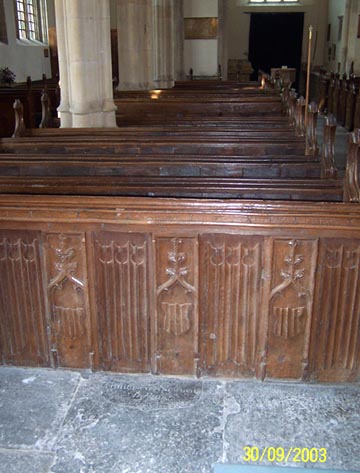
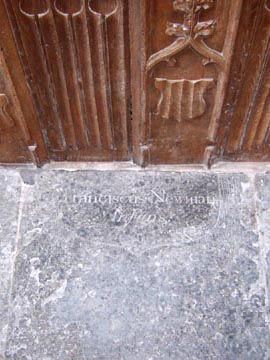
Left and Centre: The sole Newman memorial left in the floor of North
Cadbury church, to Baby Francis Newman.
Right: Bennett memorials on the northeast wall of the nave.
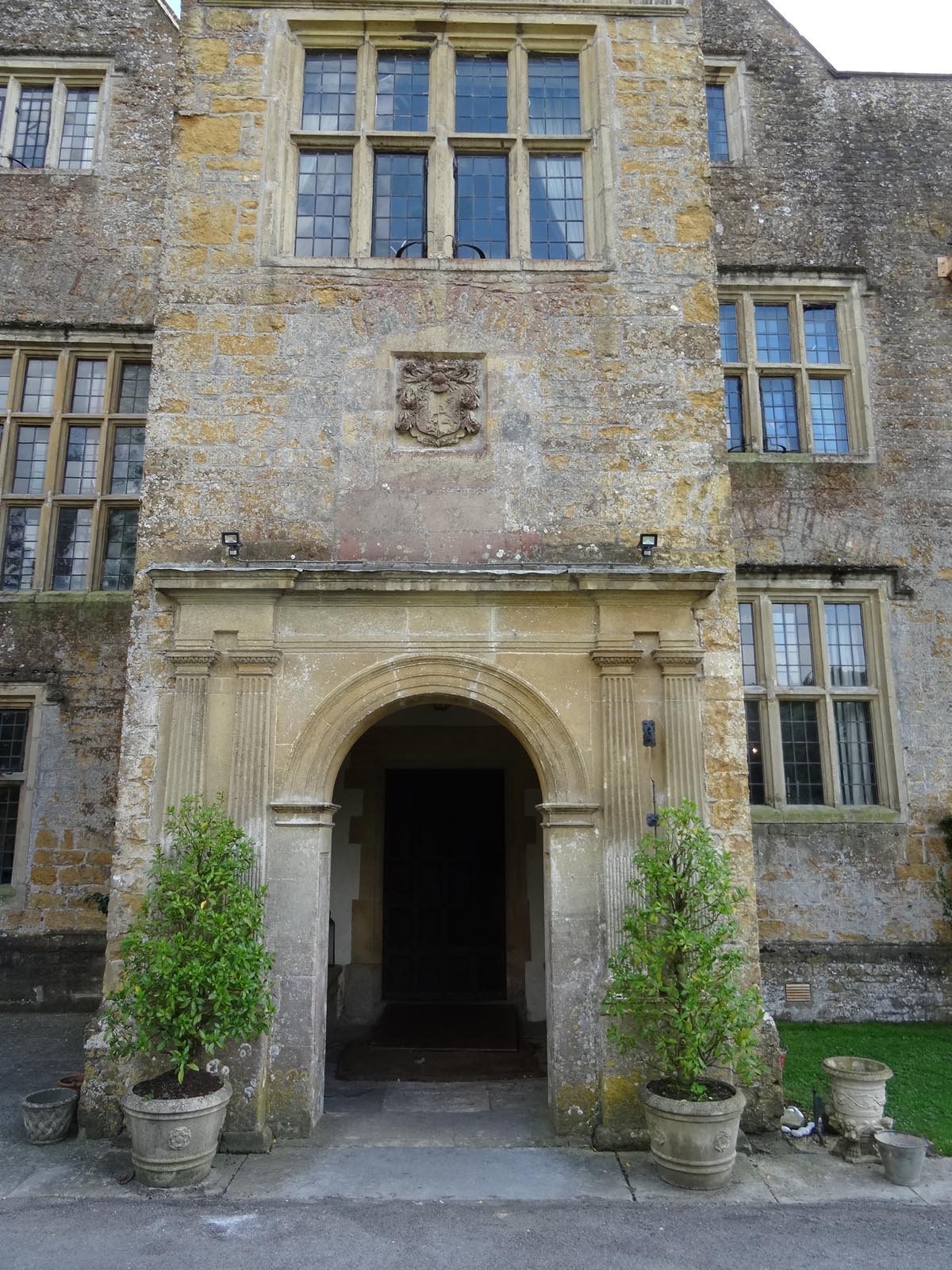
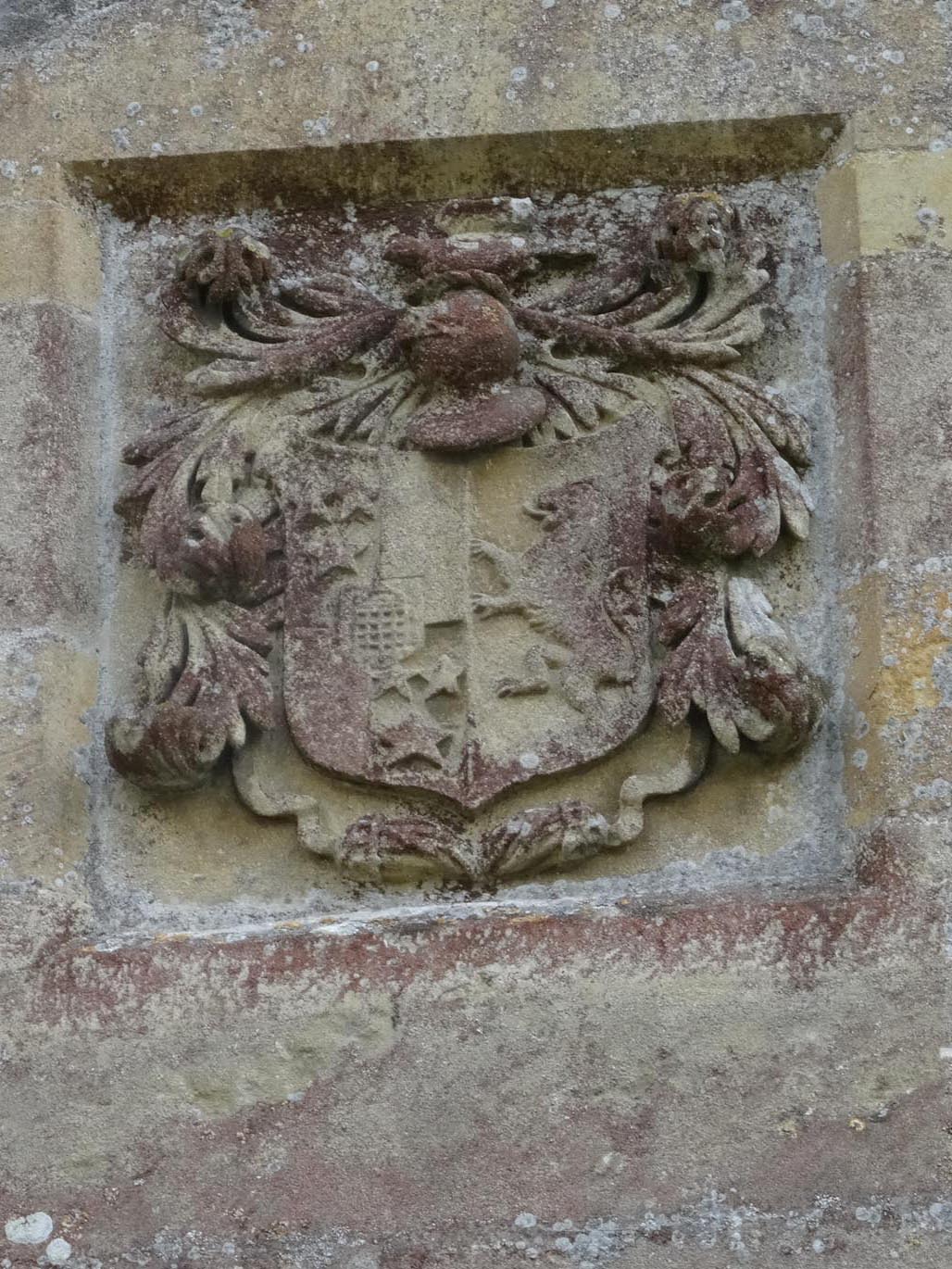
Newman coat of arms as reinstated over the north entrance of Cadbury Court
More information on the history of the Court can be found in Sam Miller's book "From Parsons Quarter to Purgatory, A History of North Cadbury, Woolston and Galhampton - three villages, one parish" Castle Cary Press 1988.
More photos of Cadbury Court can be found (under password protection) through this link.
See also extensive description of North Cadbury and the Barony of North Cadbury on Wikipedia.
The lovely North Cadbury church which must once have been the private chapel to the estate, is located on the western side of Cadbury Court, and dates back to 12th or 13th century. The delightful porch-entrance to the churchyard faces the main driveway into the Court.
Local antiquarian, Sam Miller, has made a list of baptisms and burials from the church records which includes the following entries for Newmans:
|
|
||
| Charles, son of Francis Holles Newman |
|
John, son of Francis Holles Newman |
|
| Henry Mompesson, son of Francis Holles Newman |
|
Francis Holles Newman |
|
| John, son of Francis Holles Newman |
|
William Newman son of Francis Holles Newman |
|
| William, son of Francis Holles Newman |
|
Henry Newman son of Francis Holles Newman |
|
| Eleanor, daughter of Francis Holles Newman |
|
Charles Newman |
|
| Ann, daughter of Francis Holles Newman |
|
Dorothy wife of Francis Newman of North Cadbury |
|
| Eleanor Mompesson, daughter of Charles and Mary? |
|
Richard Newman (of Horsington) |
|
| Francis, son of Francis Newman |
|
Francis Newman of North Cadbury |
|
| Henry, son of Francis Newman |
|
Mary Newman widow of Richard of Horsington |
|
| Frances Charlotte, daughter of Francis Newman |
|
Francis Newman son of Francis and Frances (see below) |
|
| Augusta Catherine, daughter of Francis Newman |
|
Ann Newman of Cerne, Dorset? |
|
| Henry Newman son of Francis and Frances |
|
||
| Jane, wife of Francis Newman |
|
||
| Augusta Catherine daughter of Francis and Frances |
|
||
It appears that baby Francis Newman (son of Francis and Frances) is the only Newman with an extant memorial in North Cadbury church. Sam Miller pointed it out to me in Sept 2003, in the stone floor in front of the pews on the south side of the nave (see photo above). Young Francis was baptized in North Cadbury on May 28th 1779 and buried there on June 18th of the same year. However, according to "The history and antiquities of Somersetshire Vol 1, Parts 3-6" by William Phelps (page 398), there is also a flat stone within the church dedicated to "Richard Newman, Gent. died 5th April 1767, aged 37. Also, Mary his wife, died July 31st, 1773, aged 79 years". This must be Richard Newman of Horsington and his wife Mary (née Bull).
Sam Miller believes most or all the other Newmans buried at North Cadbury lie in a crypt below the chancel floor.
Discussion on the history of the Newman ownership of Cadbury Court and the North Cadbury Estates
As mentioned above, there is conflicting information as to which Newman purchased the Cadbury estates and when. Phelps and others claim that it was purchased by the Newmans in 1610, but the Somersetshire Archaeological and Natural History Society put the date much later at 1685, saying an Arthur Duck owned the estates of prior to his death in 1649 when they were inherited by his daughter Mary (m. William Harbord) and that (according to Frederic Weaver's Notes & Queries for Somerset ad Dorset) she and her husband sold them her brother-in-law to Richard Newman in 1685. Indeed this seems a more likely scenario, because it was this Richard who appears to have made his fortune as a lawyer in London following the Restoration and who invested in several other estates in the West Country, including Evercreech Park, Fifehead and Thornbury Park in Gloucestershire.
Researcher Di Clements in the 1990s provided me with the information from Collinson that upheld the 1610 procurement date::
The Newmans seem to have owned the Cadburies from 1610 "when Sir Francis Hastings died having no children sold both Cadburies to Richard Newman Esq. who was High Steward of Westminster,and was imprisoned by Oliver Cromwell for his attachment to King Charles I whom he attended in his troubles and supplied with sums of money: in consideration of which services, King Charles II granted the family an augmentation of their Arms, viz. Gules a portcullis..... From this Richard descended Sir Richard and Sir Samuel Newman of Fifehead in Dorsetshire, where many of his family lie buried. The lineal descendant and present representative of this ancient family is Francis Newman Esq. who is Lord of both Manors of North and South Cadbury." From Collinson.
She also sent me the following from Phelps which appears to be largely correct:
A later historian has this to add: "The Manor and estate descended from father to son to Francis Newman, Esq. who died 1768 without issue, and by his will entailed the Manors of North and South Cadbury on Francis and Henry, the two sons of his brother Henry and their male issue in succession. The former of these enjoyed the estates until 1796 when he died leaving three daughters............ the eldest Frances Charlotte married her first cousin Francis, the eldest son of Henry Newman on whom the estates were entailed. Francis Newman the younger, during his uncle's life sold his reversionary interest in the property to James Bennet Esq of London, viz the two Cadburies in 1790 and Sparkford in 1793. On the uncle's death Mr Bennet succeeded to the estates." Phelps 1861.
My father's version of the story (below) might appear to mix up the ownership of Cadbury and Fifehead estates which adds to the confusion. In fact after Richard Newman's death, the Evercreech, Fifehead and Thornbury estates passed to the more senior branch of the family descending from Richard's elder son Richard Newman of Evercreech, while the Cadbury, Sparkford and North Lease estates passed to the junior branch via Richard's younger son Francis Holles Newman. My father's version is consistent with this where he wrote: "...the younger son of Colonel Richard, Francis Holles Newman, baptised at Fifehead on 13th February 1672 inherited the North Cadbury estate and was Sheriff of Somerset in 1745. After Sir Samuel's death in 1745, Fifehead Manor was sold to the then vicar of the parish, but North Cadbury remained in Newman hands until 1799 when it was sold to James Bennett of London to pay the debts of another Francis Newman, a spendthrift and a gambler, who was committed to the High Court, found guilty and migrated to America where he died in 1817 without male issue*. James Bennett caused the erasure of all Newman memorials in North Cadbury church, but a later owner of the manor found a stone replica of the Newman arms and incorporated it on the manor porch".
*This information about the "spendthrift and gambler" Francis Newman has since been proved wrong. He enjoyed a very full life in the USA, had many children and through them, many more descendants. He died in 1818.
What is confusing, is the wide range of dates given for the sale of Cadbury (and Sparkford) to the Bennett family. Phelps (1861) states that "Francis Newman the younger, during his uncle's life sold his reversionary interest in the property to James Bennet Esq of London, viz the two Cadburies in 1790 and Sparkford in 1793. On the uncle's death Mr Bennet succeeded to the estates". In fact, his uncle Francis Newman moved to the nearby village of Piddletrenthide shortly before his death in 1796 (or early 1797), presumably when the Cadbury and Sparkford estates were passed into the hands of the Bennetts. This is inconsistent with both Phelps and with my father's statement that North Cadbury remained in Newman hands until 1799. (See also Phelps reference to Sparkford Manor.)
Francis Newman's Will does nothing to clarify this confusion. It was dated 25 October 1794, yet refers not only to his estates in Sparkford and Cadbury, but also to his wife who reportedly died in August 1794 (or perhaps 1784).
The map below shows the location of both North and South Cadbury, bisected by the A303 to the west of Wincanton. The map shows the relative location of several other Newman homes, including Fifehead Magdalen (far right of map), Sparkford, Sturminster Newton, Sherborne, Charlton Musgrove and of course, Yeovil. Below further are some older illustrations of the house.
